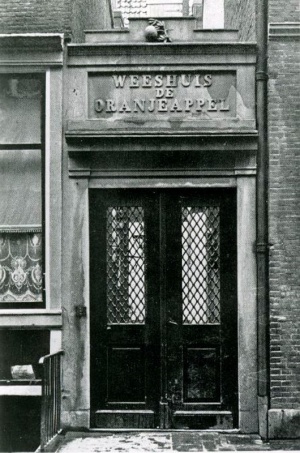Difference between revisions of "Oranjeappel, De (Amsterdam, Netherlands)"
| [checked revision] | [checked revision] |
GameoAdmin (talk | contribs) (CSV import - 20130823) |
SamSteiner (talk | contribs) (Update link to MC USA Archives) |
||
| Line 1: | Line 1: | ||
| − | [[File:AMC_X-31-1_19_13.jpg|300px|thumb|right|''De Oranjeappel. Scan | + | [[File:AMC_X-31-1_19_13.jpg|300px|thumb|right|''De Oranjeappel.<br /> |
| − | + | Scan courtesy [http://www.mennoniteusa.org/executive-board/archives/ Mennonite Church USA Archives-Goshen] X-31.1, Box 19/13'']] | |
| − | courtesy [http://www. | + | De Oranjeappel (The Orange), is the name of a Dutch [[Orphanages|orphanage]], founded in [[Amsterdam (Noord-Holland, Netherlands)|Amsterdam]] in 1675. The founders were [[Collegiants|Collegiants]], most of them being at the same time members of the Mennonite [[Lamist Mennonite Church (Amsterdam, Netherlands)|Lamist congregation]] at Amsterdam. The first governors of the orphanage, Anthony Rooleeuw, [[Bruin, Willem (1759-1826)|Willem Bruin]], Adriaan Pieters Dekker, Gerrit Jacobsz Derramout, and Pieter Rijndertsz, were all Mennonites, except Derramout. Until 1920 the orphanage was located on the Keizersgracht in Amsterdam; in this year a building was acquired at the De Lairessestraat. In 1930 the orphanage was moved to [[Hilversum (Noord-Holland, Netherlands)|Hilversum]]. |
| − | |||
| − | USA Archives-Goshen] | ||
| − | |||
| − | X-31.1, Box 19/13'']] De Oranjeappel (The Orange), is the name of a Dutch [[Orphanages|orphanage]], founded in [[Amsterdam (Noord-Holland, Netherlands)|Amsterdam]] in 1675. The founders were [[Collegiants|Collegiants]], most of them being at the same time members of the Mennonite [[Lamist Mennonite Church (Amsterdam, Netherlands)|Lamist congregation]] at Amsterdam. The first governors of the orphanage, Anthony Rooleeuw, [[Bruin, Willem (1759-1826)|Willem Bruin]], Adriaan Pieters Dekker, Gerrit Jacobsz Derramout, and Pieter Rijndertsz, were all Mennonites, except Derramout. Until 1920 the orphanage was located on the Keizersgracht in Amsterdam; in this year a building was acquired at the De Lairessestraat. In 1930 the orphanage was moved to [[Hilversum (Noord-Holland, Netherlands)|Hilversum]]. | ||
Until the end of the 18th century the orphanage was purely Collegiant, but in 1811 an agreement was made between the governors of the Oranjeappel and the deacons of the Amsterdam Mennonite congregation. Henceforth, the foundation of the Oranjeappel remaining independent, two of the four governors were to be nominated by the Amsterdam Mennonite church board, and all governors were to be members of the Amsterdam Mennonite congregation. After this agreement was made the Mennonite orphanage of Amsterdam was closed and its 17 orphans were taken into the Oranjeappel. | Until the end of the 18th century the orphanage was purely Collegiant, but in 1811 an agreement was made between the governors of the Oranjeappel and the deacons of the Amsterdam Mennonite congregation. Henceforth, the foundation of the Oranjeappel remaining independent, two of the four governors were to be nominated by the Amsterdam Mennonite church board, and all governors were to be members of the Amsterdam Mennonite congregation. After this agreement was made the Mennonite orphanage of Amsterdam was closed and its 17 orphans were taken into the Oranjeappel. | ||
Revision as of 19:28, 6 December 2013
De Oranjeappel (The Orange), is the name of a Dutch orphanage, founded in Amsterdam in 1675. The founders were Collegiants, most of them being at the same time members of the Mennonite Lamist congregation at Amsterdam. The first governors of the orphanage, Anthony Rooleeuw, Willem Bruin, Adriaan Pieters Dekker, Gerrit Jacobsz Derramout, and Pieter Rijndertsz, were all Mennonites, except Derramout. Until 1920 the orphanage was located on the Keizersgracht in Amsterdam; in this year a building was acquired at the De Lairessestraat. In 1930 the orphanage was moved to Hilversum.
Until the end of the 18th century the orphanage was purely Collegiant, but in 1811 an agreement was made between the governors of the Oranjeappel and the deacons of the Amsterdam Mennonite congregation. Henceforth, the foundation of the Oranjeappel remaining independent, two of the four governors were to be nominated by the Amsterdam Mennonite church board, and all governors were to be members of the Amsterdam Mennonite congregation. After this agreement was made the Mennonite orphanage of Amsterdam was closed and its 17 orphans were taken into the Oranjeappel.
Bibliography
Loosjes, Adriaan. Het weeshuis der Collegianten, "De Oranjeappel" 1675-1925. [Hilversum]: Weeshuis "De Oranjeappel," 1925.
| Author(s) | Nanne van der Zijpp |
|---|---|
| Date Published | 1959 |
Cite This Article
MLA style
van der Zijpp, Nanne. "Oranjeappel, De (Amsterdam, Netherlands)." Global Anabaptist Mennonite Encyclopedia Online. 1959. Web. 22 Nov 2024. https://gameo.org/index.php?title=Oranjeappel,_De_(Amsterdam,_Netherlands)&oldid=104782.
APA style
van der Zijpp, Nanne. (1959). Oranjeappel, De (Amsterdam, Netherlands). Global Anabaptist Mennonite Encyclopedia Online. Retrieved 22 November 2024, from https://gameo.org/index.php?title=Oranjeappel,_De_(Amsterdam,_Netherlands)&oldid=104782.
Adapted by permission of Herald Press, Harrisonburg, Virginia, from Mennonite Encyclopedia, Vol. 4, p. 72. All rights reserved.
©1996-2024 by the Global Anabaptist Mennonite Encyclopedia Online. All rights reserved.

